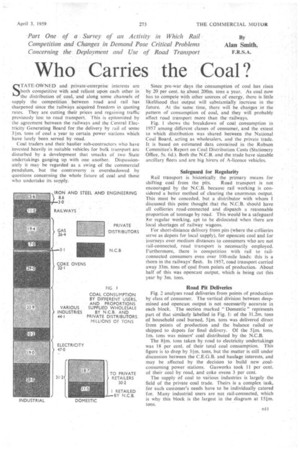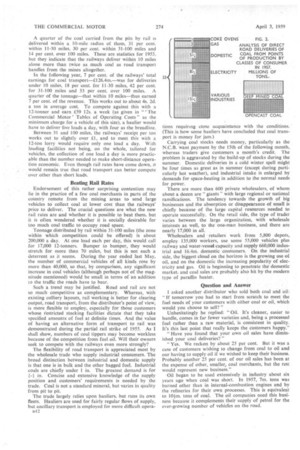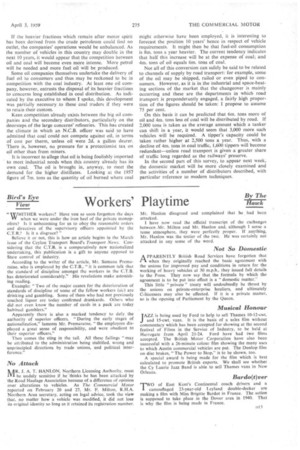Who Carries• the Coal?
Page 59

Page 60

Page 61

If you've noticed an error in this article please click here to report it so we can fix it.
STATE-OWNED and private=enterprise interests are both competitive with and reliant upon each other in the distribution of coal, and along some channels of supply the competition between road and rail has sharpened since the railways acquired freedom in quoting rates. They are cutting their prices and regaining traffic previously lost to road transport. This is epitomized by the agreement between the railways and the Central Electricity Generating Board for the delivery by rail of some 3+m, tons of coal a year to certain power stations which
have lately been served by road. .
Coal traders and their haulier sub-contractors who have invested heavily in suitable vehicles for bulk transport are disturbed by a development that smacks of two State undertakings ganging up with one another. Dispassionately it may be regarded as a swing of the commercial pendulum, but the controversy is overshadowed by questions concerning the whole future of coal and those who undertake its supply. Since pre-war days the consumption of coal has risen by. 20 per cent. to about 200m tons a year. As coal now has to compete with other sources of energy, there is little likelihood that output will substantially increase in the future. At the Same time, there will be changes in thefl pattern of consumption of coal, and they will probably affect road transport more than the-railways.
Fig. 1 shows the breakdown of coal consumption in 1957 among different classes of consumer, and the extent to which distribution was shared between the National Coal Board, acting as wholesalers, and the private trade. It is based on estimated data contained in the Robson Committee's Report on Coal Distribution Costs (Stationery Office, 5s. 6d.). Both the N.C.13. and the trade have sizeable ancillary fleets and are big hirers of A-licence vehicles.
Safeguard for Regularity
Rail transport is historically the primary means for
shifting coal from the Pits. Road transport is not encouraged by the N.C.B. because rail working is considered'a better method of clearing the enormous output. This must be conceded, but a distributor with whom discussed this point thought that the N.C.B. should have all collieries road-connected and dispatch a reasonable proportion of tonnage by road. This would be a safeguard
r regular Working, apt to be dislocated when there are local shortages of railway Wagons.
For short distance delivery from pits (where the collieries serve as depots for local supply), for opencast coal and for journeys over Medium distances to consumers who are not rail-connected, road transport is necessarily employed. Furthermore, there is competition with rail to railconnected consumers even over 100-mile leads: this is a thorn in the railways' flesh. In 1957, road transport carried away 33m. tons of coal from points of production. About half of this was opencast output, which -is being cut this year by 3m. tons.
Road Pit Deliveries Fig. 2 analyses road deliveries from points of production by class of consumer. The vertical division between deepMined and opencast output is not necessarily accurate in each block. The section marked " Domestic " represents part of that similarly labelled in Fig. 1: of the 31.2rn. tons of household coal burned, 5fm, tons was delivered direct from points of production and the balance railed or shipped to depots for final delivery. Of the 5.lTrn. tons, lm. tons was miners' coal distributed by the N.C.B.
The 81m. tons taken by road to electricity undertakings was 18 per cent, of their total coal consumption. This figure is to drop by 3-1-rn. tons, but the matter is still under discussion between the C.E.G.B. and haulage interests, and may be affected by the decision to build new ,coalconsuming power stations. Gasworks took 11 per cent. of their coal by road, and coke ovens 3 per cent.
The supply of coal to various industries is largely the field of the private coal trade. Theirs is a complex task, for each customer's needs have to be individually catered for. Many industrial users are not rail-connected, which is why this block is the largest in the diagram at 15-1.-m. tons. A quarter of the coal carried from the pits by rail is delivered within a 10-mile radius of them, 31 per cent. within 11-30 miles, 30 per cent. within 31-100 miles and 14 per cent over 100 miles. These are statistics for 1955, but they indicate that the railways deliver within 10 miles alone more than twice as, much coal as road transport handles from the mines altogether.
In the following year, 7 per cent. of the railways' total earnings for coal transport-126.4m.—was for deliveries under 10 miles, 18 per cent. for 11-30 miles, 42 per cent. for 31-100 miles and 33 per cent. over 100 miles. A quarter of the tonnage—that within 10 miles—thus earned 7 per cent, of the revenue. This works out to about 4s. 2d. a ton in average cost. To compete against this with a 12-tonner and earn £59 12s, a week (as given in "'The Commercial Motor' Tables of Operating Costs" as the minimum charge for a vehicle of this size), a haulier would have to deliver five loads a day, with four as the breadline.
Between 31 and ma miles, the railways' receipt per ton works out to slightly over £1, and to meet this with a 12-ton lorry would require only one load a day. With loading facilities not being, on the whole, tailored for vehicles, the collection of one load a day is more practicable than the number needed to make short-distance operation economic. Even though rail rates have come down, it would remain true that road transport can better compete over other than short leads.
Beating Rail Rates
Endorsement of this rather surprising contention may lie in the practice of a few coal merchants in parts of the country remote from the mining areas to send large vehicles to collect coal at lower cost than the railways' price to deliver. The crucial questions are what the new rail rates are and whether it is possible to beat them, but it is often wondered whether it is socially desirable for too much coal traffic to occupy road space.
Tonnage distributed by rail within 31-100 miles (the zone within which competition could be offered) is about 200,000 a day. At one load each per day, this would call for 17,000 12-tonners, Bumper to bumper, they would stretch for more than 70 miles, but this is not such a deterrent as it seems. During the year ended last May, the number of commercial vehicles of all kinds rose by more than 40,000, so that, by comparison, any significant increase in coal vehicles (although perhaps not of the magnitude mentioned) would be small in terms of an addition to the traffic the roads have to bear.
Such a trend may be justified. Road and rail are not so much competitive as complementary. Whereas, with existing colliery layouts, rail working is better for clearing output, road transport, from the distributor's point of view, is more flexible to employ, especially for those customers whose festricted stocking facilities dictate that they take specified amounts of fuel at definite times. And the value of having an alternative form of transport to rail was demonstrated during the partial rail strike of 1955. As I shall show, numbers of coal tippers may become workless because of the competition from fuel oil. Will their owners seek to compete with the railways even more strongly?
The flexibility of road transport is appreciated most by the wholesale trade who supply industrial consumers. The broad distinction between industrial and domestic supply is that one is in bulk and the other bagged fuel. Industrial coals are chiefly under 1 in. The greatest demand is for in. Concise and extensive knowledge of the supply position and customers' requirements is needed by the trade. Coal is not a standard mineral, but varies in quality from pit to pit.
The trade largely relies upon hauliers, but runs its own fleets. Hauliers are used for fairly regular flows of supply, but ancillary transport is employed for more difficult opera D12 tions requiring close acquaintance with the conditions. (This is how some hauliers have concluded that coal transport is money for jam.) Carrying coal stocks needs money, particularly as the N.C.B. want payment by the 15th of the following month, whereas traders give customers a month's credit The problem is aggravated by the build-up of stocks during the summer. Domestic deliveries in a cold winter spell might be four times as great as in summer (except during particularly hot weather), and industrial intake is enlarged by demands for space-heating in addition to the normal needs for power.
There are more than 600 private wholesalers, of whom about a dozen are "giants" with large regional or national ramifications. The tendency towards the growth of big businesses and the absorption or disappearance of small is chiefly because of the large capital resources needed to operate successfully. On the retail side, the type of trader varies between the large organization, with wholesale interests as well, to the one-man business, and there are nearly 17,000 in all.
Wholesalers and retailers work from 5,800 depots, employ 135,000 workers, use some 55,000 vehicles plus railway and water-vessel capacity and supply 660,000 industrial and 16.4m. domestic consumers. On the industrial side, the biggest cloud on the horizon is the growing use of oil, and on the domestic the increasing popularity of electricity and gas. Oil is beginning to penetrate the domestic market, and coal sales are probably also hit by the modern type of paraffin heater.
Question and Answer
I asked another distributor who sold both coal and oil: "If tomorrow you had to start from scratch to meet the fuel needs of your customers with either coal or oil, which would you choose to sell?"
Unhesitatingly he replied: "Oil. It's cleaner, easier to handle, comes in far fewer varieties and, being a processed fuel rather than a raw material, is consistent in quality. It's this last point that really keeps the customers happy."
"Have you found that your own oil sales have diminished your coal deliveries? "
"Yes. We reckon by about 25 per cent. But it was a case of customers wishing to change from coal to oil and our having to supply oil if we wished to keep their business. Probably another 25 per cent. of our oil sales has been at the expense of other, smaller: coal merchants, but the rest would represent new business."
• Oil began to be used extensively in industry about six years ago when coal was short. In 1957, 7m. tons was burned other than in internal-combustion engines and by the refineries for their own processes. This is equivalent to 101m. tons of coal. The oil companies need this business because it complements their supply of petrol for the ever-growing number of vehicles on the road, lithe heavier fractions which remain after motor spirit has been derived from the crude petroleum could find no outlet, the companies' operations would be unbalanced. As the number of vehicles in this country may double in the next 10 years, it would appear that the competition between oil and coal will become even more intense. More petrol will be needed and more fuel oil will be produced.
Some oil companies themselves undertake the delivery of fuel oil to consumers and thus may be reckoned to be in competition with the coal industry. At least one oil company, however, entrusts the disposal of its heavier fractions to concerns long established in coal distribution. As indicated by the executive to whom I spoke, this development was partially necessary to these coal traders if they were to retain their custom.
Keen competition already exists between the big oil companies and the secondary distributors, particularly on the doorsteps of the large concerns' refineries. This has created the climate in which an N.C.B. officer was said to have admitted that coal could not compete against oil, in terms of cost per therm, unless oil were 2d. a gallon dearer. There is, however, no pressure for a protectionist tax on oil other than from miners.
It is incorrect to allege that oil is being foolishly imported to meet industrial needs when this country already has its own coal. The oil is brought in, anyway, to meet the demand for the higher distillates. Looking at the 1957 figure of 7m. tons as the quantity of oil burned where coal
might otherwise have been employed, it is interesting to forecast the position 10 years' hence in respect of vehicle requirements. It might then he that fuel-oil consumption is 8m. tons a year heavier. The current tendency indicates that half this increase will be at the expense of coal; and 4m. tons of oil equals 6m. tons of coal.
Not all of this conversion can safely be said to be related to channels of supply by road transport: for example, some of the oil may be shipped, railed or even Piped to consumers. However, as it is in the industrial and space-heating sections of the market that the changeover is mainly occurring and these are the departments in which road transport is preponderantly engaged, a fairly high proportion of the figures should be taken: I propose to assume 75 per cent.
On this basis it can be predicted that 6m. tons more of oil and 4m. tons less of coal will be distributed by road. If 2,000 tons is taken as the average amount which a tanker can shift in a year, it would seem that 3,000 more such vehicles will be required. A tipper's capacity could be taken rather higher at 2,500 tons a year. Thus, with a decline of 4m. tons in coal traffic, 1,600 tippers will become redundant—unless road transport is given a greater share of traffic long regarded as the railways' preserve.
In the second part of this survey, to appear next week, the domestic market will be more closely examined and the activities of a number of distributors described, with particular reference to modern techniques.
































































































































